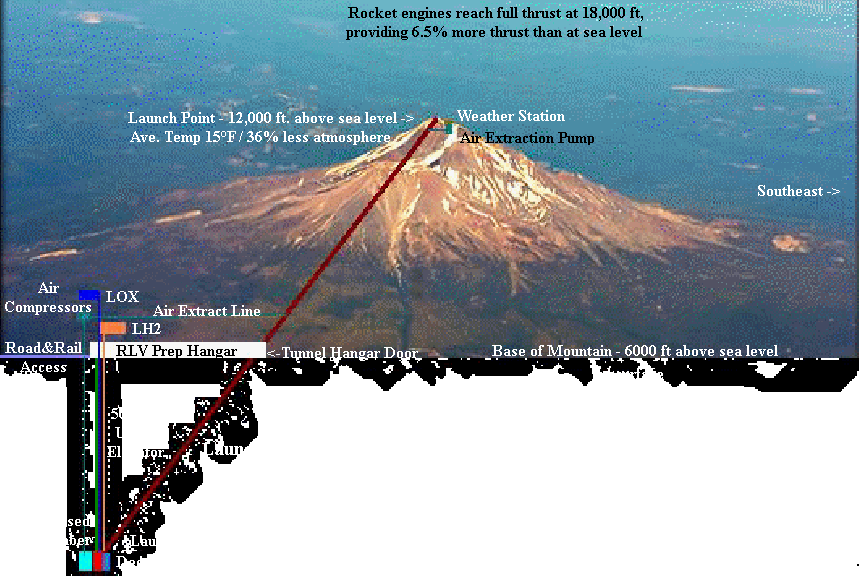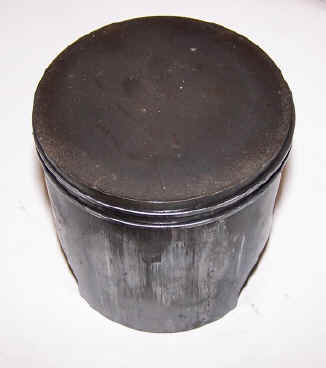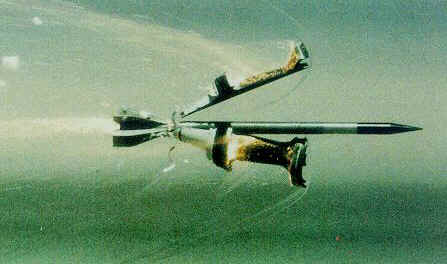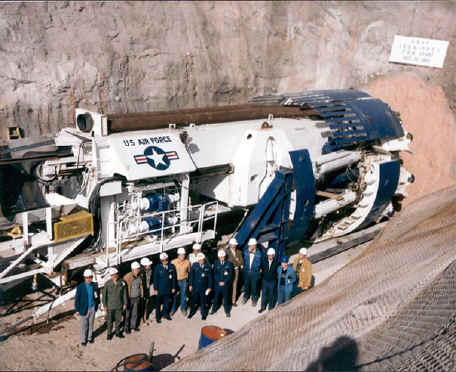SKY RAMP TECHNOLOGY
The experts at Skyramp have always considered pneumatic (compressed air) launch a superior method of assisted launch compared to rocket sled rail launch. Rocket sled capabilities are well established and it was assumed that an inclined mountainside ramp would be less expensive and more acceptable to skeptics. However, advances in Tunnel Boring Machine (TBM) technology have greatly reduced tunnel construction costs. Moreover, tunnel launch allows the construction of spaceports inside mid-sized mountains by boring below the surface as well. This is the only option for building a Single-Stage-To-Orbit (SSTO) assisted launch spaceport within the USA.
Pneumatic Inclined Tunnel Launch

___________________________________________________________________________________
In this example, a 12,000 ft mountain is used; there are dozens this size in the American West. However, these mountains are only around 6000 feet tall, as measured from their base. Therefore, a launch tunnel must begin 5000 ft below the Earth's surface. Due to its 55 degree angle, the tunnel is 2.54 miles in length to accommodate the 2.5 mile requirement to launch an X-33-size SSTO RLV into orbit. This is the ideal angle for space launch, and today's vertically launched spacecraft turn toward that angle after launch. There are several methods of pneumatic launch that have been studied for decades, known at Vactrain. This example uses the most simple, where compressed air rapidly pushes a piston up a steel-clad tunnel. A 2001 NASA study confirmed the viability of a pneumatic accelerator for space launch.
Launch Sequence
 An RLV is
prepared for launch in the RLV Prep Hangar on the surface.
Two lightweight disposable sabots
are fitted tightly around the RLV to provide a
smooth conical shape to enable safe movement within the tunnel. When ready,
the RLV is
inserted into the tunnel though a large Tunnel Hangar
Door and placed
atop a massive piston (depicted at right), which was locked into place for
loading.
An RLV is
prepared for launch in the RLV Prep Hangar on the surface.
Two lightweight disposable sabots
are fitted tightly around the RLV to provide a
smooth conical shape to enable safe movement within the tunnel. When ready,
the RLV is
inserted into the tunnel though a large Tunnel Hangar
Door and placed
atop a massive piston (depicted at right), which was locked into place for
loading.
The hangar door is closed and huge industrial air compressors build pressure in the compression chamber some 5000 feet below. They also extract air from the tunnel above the RLV, creating a vacuum. This air builds pressure below the piston until it can support the weight of the RLV. The piston is unlocked and air slowly released to lower the RLV down into the Launch Chamber at the bottom of the tunnel. The air compressors continue working to build up intense pressure in the compressed air chamber.
The launch chamber has a cooling Deep Freeze system that lowers its temperature to around -360°F. This solves most cryogenic problems associated liquid oxygen (LOX) and liquid hydrogen (LH2), which are pumped down from the surface. (These problems are discussed below.) All this can be done remotely, although a 5000 ft Utility Elevator is available for access to the underground facilities.
Once the LOX and LH2 are loaded, the tunnel vacuumed of air, the compression chamber fully pressurized, and the small weather station at the top of the mountain assures a safe exit, the launch can begin. Computer controlled valves open to rapidly accelerate the RLV up the tunnel at a steady 6gs or less. As the piston/RLV moves upward, trace air elements accumulate. A mountaintop air extraction pump may be required to reduce this growing pressure. Nevertheless, air pressure will build at the nose of the RLV, and that is a good thing. This air will automatically pop open the lightweight tunnel exit hatch a second before the RLV exits. This built up pressure ensures a smooth transition as the RLV exits and encounters the atmosphere.
 As the RLV
exits, its disposable sabots automatically fall away. Pictured at left is the U.S. Army's
proven APFSDS tank gun round, which departs a 120mm smooth bore barrel at Mach 5
at
sea level with no problems. Sabots allow a variety of RLV shapes or conical
expendable rockets to fit inside the launch tunnel. Sabots are nothing more than
disposable packing material.
As the RLV
exits, its disposable sabots automatically fall away. Pictured at left is the U.S. Army's
proven APFSDS tank gun round, which departs a 120mm smooth bore barrel at Mach 5
at
sea level with no problems. Sabots allow a variety of RLV shapes or conical
expendable rockets to fit inside the launch tunnel. Sabots are nothing more than
disposable packing material.
The piston will shoot out the tunnel as well and fall way. It is just a cheap slug, but may be recovered for reuse. It may contain a GPS transmitter or perhaps a parachute. On the other hand, the Space Shuttle program has taught us that recovering and repairing reusable components can become more expensive than buying new ones. After tunnel exit, the RLV fires its engines to continue ascent. Unlike vertical launch, the RLV has Mach 2 velocity when its engines are fired, so if an engine fails it can abort with plenty of altitude and velocity to land at a distant airstrip.
Advantages of Pneumatic Launch
Pneumatic launch has several advantages over rocket rail launch that allow it to launch larger payloads, or launch at lesser Gs. For example, Dr. Maker's calculations for launching an X-33 SSTO assumes a 45 degree mountainside launch angle, while a tunnel allows a superior 55 degrees. In addition, the deep freeze sheds significant empty weight in the form of propellant tank insulation and structural weight.
 A major advantage of tunnel launch is there is little
environmental impact, and no complaints that it may damage a mountain's beauty.
Plants and animals remain undisturbed since none live near 12,000 feet. Pneumatic
launch is nearly silent to people living 6000 ft below. Moreover, there
are very few locations in the world that allow a 45 degree eastward launch ramp away
from populated areas. On the other hand, tunnels can be cut in almost any
mountain in any direction. The U.S. Air Force has extensive experience
boring large tunnels for nuclear test shots, and has its own TBMs.
(right) They have bored over a hundred tunnels up to 2.5 miles long for
nuclear test shots and secret facilities.
A major advantage of tunnel launch is there is little
environmental impact, and no complaints that it may damage a mountain's beauty.
Plants and animals remain undisturbed since none live near 12,000 feet. Pneumatic
launch is nearly silent to people living 6000 ft below. Moreover, there
are very few locations in the world that allow a 45 degree eastward launch ramp away
from populated areas. On the other hand, tunnels can be cut in almost any
mountain in any direction. The U.S. Air Force has extensive experience
boring large tunnels for nuclear test shots, and has its own TBMs.
(right) They have bored over a hundred tunnels up to 2.5 miles long for
nuclear test shots and secret facilities.
NASA hires contractors to keep birds away from spacecraft on launch pads in Florida. Birds like tall objects to build nests while woodpeckers peck at things, like the Shuttle's insulation. Moreover, a bird strike during a launch could cause catastrophic damage. Insects may cause problems too. The B-2 bomber crash in Guam was caused by a wasp building a nest on a sensor. These are not issues with tunnel launch. Launch plans at sea-level seaports are plagued by bad weather. Rail launch means that high winds are much less a factor, although ice accumulation on the rails presents minor problems, which don't exist with tunnel launch.
Sections of the Skyramp website explain how rockets at vertical launch pads waste tremendous fuel for three seconds until full thrust is achieved for "blast off." A tunnel or rail launched RLV 's engines don't ignite until after launch, so this fuel is not wasted. Once it reaches full thrust three seconds later at 18,000 ft, it's engines produce 6.5% more thrust than at sea level because the thin atmosphere does not pinch its rocket plume. Additional weight may be shed by using a payload fairing rather than an internal cargo bay, and the option of water landing. These issues are discussed in detail elsewhere in the Skyramp website.
Spaceport Advantages
Other advantages of tunnel launch are in the spaceport itself. A huge problem at sea-level spaceports is the physical plant deterioration due to humidity laced with salt water and frequent thunderstorms. In Florida, hurricanes make an appearance each decade to cause major devastation. Another problem is that a failed launch occurs every few years that destroys a billion dollar launch site.
Tunnel launch eliminates the expensive and complex security challenges faced by launch pads. Someone with a rifle can cause catastrophic damage to vertical rockets on a pad or at launch. A few years ago, a drunk with a hunting rifle shot a hole in the Alaskan oil pipeline, requiring it to shut down for several days. The danger of local crazies taking shots at a space rocket is a major threat. Given its huge size, someone with a common hunting rifle could hit a rocket system from two miles away.
Secrecy is another advantage of tunnel launch. Advanced nations track each other's spy satellites. Their own satellites provide several days warning as a spacecraft is prepared at an open launch pad. The massive blast-off is easy to detect and a rocket's trajectory can be followed to note the position of new satellites. With tunnel launch, satellite launch detection would be lucky, if not impossible.
If world war ever erupts, open sea-level spaceports are vulnerable to attack. A submarine-launched conventional cruise missile targeted at a fueled rocket would destroy it and the entire launch complex. Destroying a tunnel launch complex would prove impossible without a major nuclear weapon. Since they would be located around 1000 miles inland, they are beyond the range of enemy ship or submarine-based commando or missile attack.
Deep Freeze
This advantage tips the scales heavily in favor of tunnel launch. A major challenge in space flight is fueling spacecraft with ultra-cold liquid propellant (LOX at −297°F) and (LH2 at −434°F). Tunnel launch allows the launch chamber to be cooled prior to fueling, so the fuel tanks needn't be extremely strong (i.e. heavy and expensive) to withstand the force of holding LOX and LH2 for hours at 100°F sea level with direct sunlight. Oxygen freezes solid at -362°F, so the chamber would be cooled to -360°F, which presents a minor problem to accommodate the −434°F LH2.
This eliminates the cost and weight of insulation. The Space Shuttle's external tank requires over 4000 lbs of insulation. This insulation merely slows the atmospheric heating of the LOX and LH2, so they "boil" and release gases until launch, which requires continuous fueling at the pad. During launch, the engines fire for three seconds to reach full thrust and torch the launch pad until released. Needless to say, a "blast off" is a complex and dangerous method. In addition, a launch delay of more than a couple of hours requires defueling the tanks, whereas a fueled RLV in deep freeze can stand ready for days while minor problems are fixed or weather clears.
Another advantage is this allows the safe use of "deep cryo", i.e. further freezing to −340°F to allow denser LOX in the tanks. Space-X uses this in Florida since it can allow up to 30% more payload in orbit. The problem is that warming cryo boils out, but deep cryo vents gaseous, making the technique more hazardous, which caused a Space-X rocket to explode on the pad in 2016. Deep Freeze eliminates this problem.
A tunnel launched RLV needs no insulation if the launch chamber is in "Deep Freeze," while the sabots provide insulation during the six second tunnel ascent. Once the RLV hits the atmosphere at 12,000 feet, the outside air is ~15°F and drops quickly during the two minute flight into space. This allows substantial cost and weight savings, and is much safer.
Tunnel Demonstrator
 An interesting
aspect of tunnel launch is that testing is inexpensive. A simple mock-up can be shot out the tunnel to test performance and identify problems. Since it may take
years to develop an RLV, current expendable rocket systems could be launched,
minus their first stage. They could be "stacked" through the tunnel
hangar door since the air compressor can adjust the height of the piston. The
piston /air compressor system provides an elevator for access throughout the
launch tunnel and up to the mountaintop. A maintenance piston could be built for
this purpose, so a 5000 foot underground utility elevator may not be needed.
An interesting
aspect of tunnel launch is that testing is inexpensive. A simple mock-up can be shot out the tunnel to test performance and identify problems. Since it may take
years to develop an RLV, current expendable rocket systems could be launched,
minus their first stage. They could be "stacked" through the tunnel
hangar door since the air compressor can adjust the height of the piston. The
piston /air compressor system provides an elevator for access throughout the
launch tunnel and up to the mountaintop. A maintenance piston could be built for
this purpose, so a 5000 foot underground utility elevator may not be needed.
Ideal test missiles are the U.S. Government's surplus of MX inter-continental ballistic missiles left over the the Cold War. These are designed for pneumatic launch! This was because launches had destroyed the expensive launch silos, so a pneumatic system was designed to shoot the MX missile out of the silo prior to engine ignition. (right) These are now sold to a private launch company for commercial use, where the tiny assisted launch allows 10% more payload. This is hard evidence that pneumatic launch is viable, and mathematics prove its assist can enable SSTO.
©2010 Sky Ramp Technology